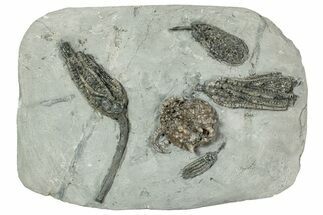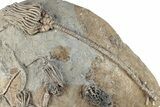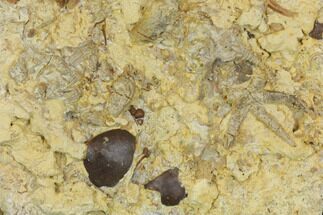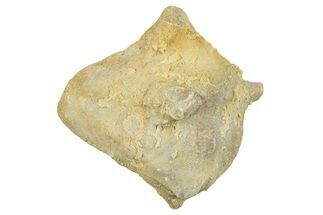This Specimen has been sold.
13" Fossil Crinoid Plate With Ten Species - Crawfordsville, Indiana
This is an incredible crinoid and starfish association plate that features ten separate species of crinoids (16 total crinoids), collected from the Edwardsville Formation of Crawfordsville, Indiana. The crinoids include two of the species Cyathocrinites harrodi, Lanecrinus depressus, Decadocrinus tumidulus, two of the species Pachylocrinus aequalis, Scytalocrinus decadactylus, two of the species Actinocrinites gibsoni, Agaricocrinus splendens, four Macrocrinus mundulus crinoids, Forbesiocrinus multibrachiatus, and Taxocrinus colletti. A starfish (Onychaster flexilis) can be seen partially exposed just beneath the Actinocrinites gibsoni crinoid towards the top left corner of the plate.
The preparation on these fossils is exquisite - using skillful air-abrasion techniques under a stereo microscope.
#16 - Cyathocrinites harrodi (x2)
#21 - Lanecrinus depressus
#23 - Decadocrinus tumidulus
#35 - Pachylocrinus aequalis (x2)
#47 - Scytalocrinus decadactylus
#52 - Actinocrinites gibsoni (x2)
#55 - Agaricocrinus splendens
#69 - Macrocrinus mundulus (x4)
#78 - Forbesiocrinus multibrachiatus
#83 - Taxocrinus colletti
#89 - Starfish Onychaster flexilis
The crown of the largest Actinocrinites gibsoni has been mounted to the rock, though the stem was already present within the rock. There is a repaired crack through the calyx of the Macrocrinus mundulus at the top left corner of the specimen, and some spots of restoration to the Agaricocrinus splendens crinoid and Cyathocrinites harrodi crinoid towards the bottom right corner of the plate.
The preparation on these fossils is exquisite - using skillful air-abrasion techniques under a stereo microscope.
#16 - Cyathocrinites harrodi (x2)
#21 - Lanecrinus depressus
#23 - Decadocrinus tumidulus
#35 - Pachylocrinus aequalis (x2)
#47 - Scytalocrinus decadactylus
#52 - Actinocrinites gibsoni (x2)
#55 - Agaricocrinus splendens
#69 - Macrocrinus mundulus (x4)
#78 - Forbesiocrinus multibrachiatus
#83 - Taxocrinus colletti
#89 - Starfish Onychaster flexilis
The crown of the largest Actinocrinites gibsoni has been mounted to the rock, though the stem was already present within the rock. There is a repaired crack through the calyx of the Macrocrinus mundulus at the top left corner of the specimen, and some spots of restoration to the Agaricocrinus splendens crinoid and Cyathocrinites harrodi crinoid towards the bottom right corner of the plate.
Crinoids from the Ramp Creek Limestone were likely buried in sediment from nearby deltas during storms. The resulting siltstone deposits are soft enough that fossils can be extracted in exquisite, three-dimensional relief.
Crinoids, sometimes commonly referred to as sea lilies, are animals, not plants. They are echinoderms related to starfish, sea urchins, and brittle stars. Many crinoid traits are like other members of their phylum. Such traits include tube feet, radial symmetry, a water vascular system, and appendages in multiples of five (pentameral). They first appeared in the Ordovician (488 million years ago) and some species are still alive today.
Crinoids, sometimes commonly referred to as sea lilies, are animals, not plants. They are echinoderms related to starfish, sea urchins, and brittle stars. Many crinoid traits are like other members of their phylum. Such traits include tube feet, radial symmetry, a water vascular system, and appendages in multiples of five (pentameral). They first appeared in the Ordovician (488 million years ago) and some species are still alive today.
SPECIES
Various
LOCATION
Crawfordsville, Indiana
FORMATION
Edwardsville Formation
SIZE
Rock: 13 x 8.9"
CATEGORY
SUB CATEGORY
ITEM
#281493
We guarantee the authenticity of all of our specimens.
 Reviews
Reviews
















